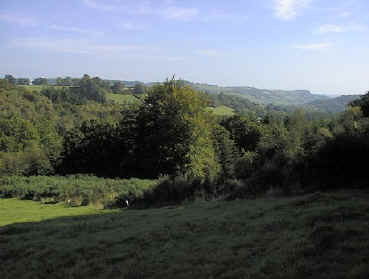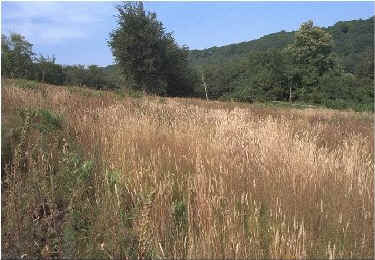The Woodland Education Centre
Heathland Project Report Report Introduction Contents Summary
 Conclusions
Conclusions
left: view South East across the Heathland Restoration site.
The initial vegetation cover on the project site was very heterogeneous. This was a direct consequence of the extremely diverse seed bank which must have accumulated in the soil over many years. Selective germination from this diverse seed bank, in response to differing environmental conditions across the site, led to the production of a clearly non-uniform initial plant cover. The survey carried out in 1996 served as a base-line survey which identified these initial vegetational differences, as yet unrelated to differing management techniques in the sections.
The initial heterogeneity of the vegetation is slowly declining, as those species favoured by current conditions spread and those which are unsuited, die out. (Current conditions on the site are the result of a combination of climatic factors and the prevailing management regime.) Overall, the vegetation on the project site is making slow but steady progress towards becoming a dry heath community.

Above: view looking north across the Heathland Restoration site.
The northern sections of the project site (5 - 9) are more favourable for the development of heath species than the southern sections (1 - 4). The southern sections are heavily influenced by adjacent woodland and to date, show no sign of developing a heath-type community.
Differing management techniques have now resulted in clearly visible differences between strips with different management regimes.
The control strip (5), which has been left untouched, provides a good example of what conditions would be like on much of the project site in the absence of any management. It is now dominated by Gorse (Ulex europaeus) which is over head height (ca 2m tall), and by tree seedlings such as Silver Birch (Betula pendula), Cherry (Prunus sp.), Willow (Salix caprea agg. and S. aurita) and Rhododendron (Rhododendron ponticum). The vegetation here forms a thick almost impenetrable cover, permeated by Brambles (Rubus fruticosus agg.) and with occasional grassy clearings where Heather (Calluna vulgaris) and Bell Heather (Erica cinerea) grow in isolated patches.
The vegetation present on other sections of the site is the result of an amalgam of controlling factors. Local environmental factors primarily determine what is present, with modifications to this superimposed by differing management techniques.
 left:
"A" level student conducting a survey on the Heathland Restoration site.
left:
"A" level student conducting a survey on the Heathland Restoration site.
The southern sections, 1 - 4, show few clearly demarcated differences between them, except in the spring, when sections 1 and 3 are ablaze with Bluebells (Endymion nonscriptus). Sections 2 and 4 are then visibly different because the Bluebells have greatly decreased in these spring brushcut areas. At other times of the year these strips form grassy meadows. The only really visible distinction between them is the presence of more tree seedlings and bracken in section 1 because of its close proximity to the adjacent woodland. So far, in this southern region, environmental factors are paramount in determining the vegetation cover.
d